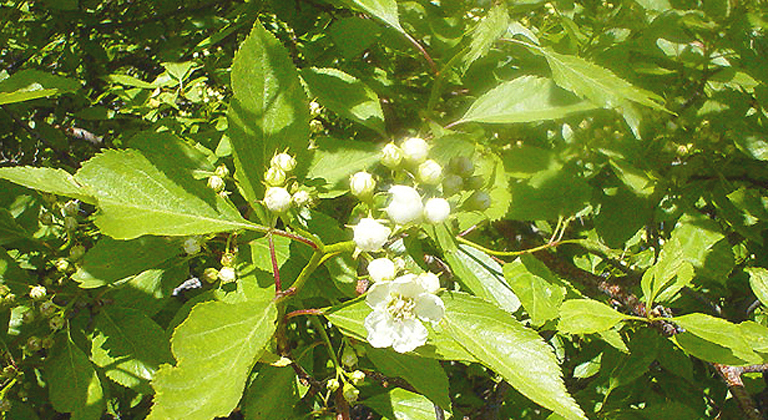

1. Hawthorn
This shrub has actually been used as a deterrent against unwanted visitors since the Middle Ages, and for good reason: It’s dense and thorny—definitely not something you’d want to slog through to get to, say, a ground-level window. It’s also a very pretty plant, with dark green foliage offsetting white rose-like blooms in the spring and bright red berries in the fall. Although it’s physically unpleasant, hawthorn’s blooms and berries are not poisonous at all. In fact, the plant has a number of well-known medicinal qualities and its berries can be made into jams and jellies. Birds and butterflies are also known to feast upon hawthorn.

2. Every rose has its…
As anyone who’s ever had to prepare a vaseful of roses can attest, the beauty of them is matched only by the amount of blood they can draw if you’re not extremely careful—or wearing thick protective gloves. What’s great about roses is that they can be grown as bushes underneath windows, or trained to climb fences and trellises to create protective barriers. They’re available in just about every color you can imagine, with different subspecies bred to thrive in a variety of climates and soil types. You’ll want to ensure that the roses you choose do have thorns, though…there are some varieties that have been bred to be nearly thornless. On the other hand, there are varieties bred for prominent, showy thorns. One gorgeous example is the “wingthorn rose,” which boasts humble white blooms but bright crimson thorns that add a pop of striking color to your garden long after both flowers and leaves have been shed for the season. Roses are considered non-toxic for humans and pets.

3. Yucca
With a robust, symmetrical round shape and tall clusters of white flowers, yucca is a very attractive plant. Its long, stiff leaves are quite spiky and unpleasant to walk into. It tends to grow best in dry climates and is most commonly associated with the Southwest, but there are varieties like beargrass yucca that do well in the Southeast. Yucca is generally considered to be non-toxic to humans, and there are species of it that have edible flowers and fruit (although you’ll definitely want to do your research before trying it). It can be mildly toxic to dogs and cats if eaten, with symptoms generally including mild vomiting and diarrhea.
It’s important to distinguish between yucca and blue agave, however. Blue agave is also a beautiful ornamental plant that thrives in extremely dry climates, and its sharp, serrated aloe-like leaves make it an excellent deterrent against intruders. However, the sap is highly toxic, causing blistering and burning upon contact with the skin, and can cause kidney and liver damage if ingested. (In fact, the Tarahumara tribe was known to put the sap on their arrows to poison them!) So this might not be the best planting if you have curious kids in the “put everything directly in the mouth” stage of their lives.

4. Barberry
There are dozens of different kinds of barberry out there, because this hardy, low-maintenance shrub is very popular as a hedge plant. It even grows well in urban environments. Although some species are thornless, the barberry is best known for its long, sharp spines. A barrier of barberry will keep all but the most determined (and heavily garbed) intruders out. Wintergreen barberry is a popular choice due to its lustrous, dark-green leaves that turn red in the fall and yellow flowers that attract butterflies and birds. Although the thorns of the barberry can be quite vicious, the plant itself is fairly non-toxic (although we wouldn’t recommend eating it). There’s evidence that the berries can be poisonous to dogs, but only in quantities that would be very difficult for the average canine to ingest.
This is in contrast to the holly bush, which is another popular ornamental that, like the barberry, is both very attractive and deeply unpleasant to walk into. Holly, however, is quite poisonous. Toddlers have grown very sick from eating as few as two of the berries.

5. Blue Spruce
The blue spruce, like other members of the pine tree family, doesn’t feature intimidating thorns or sharp leaves. That doesn’t make it pleasant to run into, though, and it can make accessing windows very difficult as long as the tree is not allowed to grow to its full height. The other positives to this tree are that it’s an attractive evergreen that offers a lovely smell…as evidenced by its popularity as a Christmas tree. Furthermore, it’s considered very non-toxic. Although the blue spruce is native to the Rocky Mountains, it grows quite well in a variety of climates, sun conditions and soil types.






































